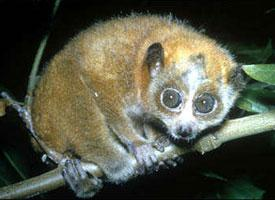
Súlyok és méretek
| Marmagasság | 21-tól 40-ig cm |
|---|
Veszélyeztetettség
| Veszélyeztetett |
Állatleírás
The Sunda slow loris (Nycticebus coucang) is a fascinating and enigmatic creature that inhabits the dense tropical rainforests of Southeast Asia, including parts of Indonesia, Malaysia, Thailand, and Singapore. This small, nocturnal primate is known for its distinctive appearance, slow movement, and unique ecological adaptations, making it a subject of great interest and concern in the realm of wildlife conservation.Characterized by its round face, large, expressive eyes, and a short snout, the Sunda slow loris has an endearing appearance that belies its survival instincts. These primates have a dense, woolly fur that ranges in color from light brown to deep reddish-brown, providing excellent camouflage amidst the dense foliage of their forest habitat. A striking feature is the dark stripe that runs along the back, extending from the head down to the tail, which is often merely a stump. Their limbs are relatively short and robust, equipped with strong, grasping hands and feet that are adept at holding onto branches for long periods, an adaptation to their arboreal lifestyle.
The Sunda slow loris is an omnivorous animal, feeding on a diet that includes fruits, insects, small birds, and eggs. They have a unique adaptation in the form of a toxic bite, a rare trait among mammals. The toxin is produced by glands located on the insides of their elbows, which they then apply to their teeth by grooming. This toxic bite serves as a defense mechanism against predators and is also used in intraspecific conflicts.
One of the most intriguing aspects of the Sunda slow loris is its slow and deliberate movement. This behavioral adaptation is thought to be a strategy to avoid detection by predators. They move silently through the trees at night, using their excellent night vision to navigate and locate food. During the day, they sleep curled up in the dense foliage or in tree hollows, further camouflaging themselves from potential threats.
The reproductive habits of the Sunda slow loris are characterized by a slow pace, in line with their overall lifestyle. Females typically give birth to a single offspring after a gestation period of about six months. The young are born well-developed and cling to their mother's belly for the first few weeks of life. Mothers invest a significant amount of care and attention in their offspring, which contributes to the slow loris's slow reproductive rate.
Despite its unique adaptations and fascinating biology, the Sunda slow loris faces significant threats from habitat loss, poaching, and the illegal pet trade. Their habitat is being rapidly degraded and fragmented due to logging, agricultural expansion, and urban development. Additionally, their cute appearance and docile nature have made them targets for the illegal wildlife trade, where they are often sold as exotic pets, a practice that involves cruel and harmful treatment.
Conservation efforts for the Sunda slow loris are focused on habitat protection, law enforcement to combat poaching and the illegal pet trade, and public education to raise awareness about the plight of this remarkable primate. International cooperation is crucial, as their range spans multiple countries with varying levels of environmental protection. The Sunda slow loris is listed as Vulnerable by the International Union for Conservation of Nature (IUCN), highlighting the urgent need for concerted conservation actions to ensure the survival of this unique and captivating species.
Új állatfotók
Top 10 állat
- Dolphin gull (Leucophaeus scoresbii)
- Diana monkey (Cercopithecus diana)
- Moustached guenon (Cercopithecus cephus)
- Galápagos tortoise (Geochelone nigra complex)
- Japanese macaque (Macaca fuscata)
- Russian tortoise (Testudo horsfieldii)
- Stone loach (Barbatula barbatula)
- Greek tortoise (Testudo graeca)
- Common flying dragon (Draco volans)
- Vendace (Coregonus albula)